离子液体气/液界面,烷基链中取向度的振动和频光谱(SFG)研究,振动和频光谱(SFG)研究,和频光谱(SFG)研究检测方案(其它光谱仪)
检测样品 其他
检测项目 取向度的振动和频光谱(SFG)研究,振动和频光谱(SFG)研究,和频光谱(SFG)研究

 金牌会员
752 篇解决方案
金牌会员
752 篇解决方案
方案详情文
智能文字提取功能测试中
Available online at www.sciencedirect.comCHEMICALPHYSICSLETTERS Chemical Physics Letters 389 (2004)321-326 322T. Iimori et al. / Chemical Physics Letters 389 (2004) 321-326 www.elsevier.com/locate/cplett Orientational ordering of alkyl chain at the air/liquid interfaceof ionic liquids studied by sum frequency vibrational spectroscopy Toshifumi Iimori a,l, Takashi Iwahashi b, Hisao Ishii b,2, Kazuhiko Seki aYukio Ouchi b,*, Ryosuke Ozawa, Hiro-o Hamaguchi, Doseok Kim d a Research Center for Materials Science, Nagoya University, Furo-cho, Chikusa-ku, Nagoya 464-8602, Japan ’Department of Chemistry, Graduate School of Science, Nagoya University, Furo-cho, Chikusa-ku, Nagoya 464-8602, Japan°Department of Chemistry, School of Science, The University ofTokyo, 7-3-1, Hongo, Bunkyo-ku, Tokyo 113-0033, Japan Department of Physics, Sogang University, Seoul 121-742, Korea Received 2 February 2004; in final form 11 March 2004Available online 15 April 2004 Abstract Orientation of cations at the air/liquid interfaces of the salts of 1-butyl-3-methyl imidazolium with tetrafluoroborate andhexafluorophosphate is studied using infrared-visible sum frequency vibrational spectroscopy. For both salts, quantitative analysesshow that the terminal methyl group of the butyl chain is polar-oriented with its symmetry axis aligned nearly vertical to the surface.@ 2004 Elsevier B.V. All rights reserved. 1.Introduction Owing to their unique chemical and physical char-S RIlacters, room-temperature ionic liquids (RILs) based onorganic cations have been extensively studied as a neo-teric and versatile solvent [1-3]. RILs have only negli-gible vapor pressures and are good solvents for manychemicals, thereby usable for a replacement of hazard-ous and volatile organic solvents. Rapidly advancingapplications of RILs include utilizations as a solvent forphase-separable catalysis [4,5]. In particular, supercriti-cal CO2/RIL systems have advantages not only in cat-alyst recycling but also in the effective extraction ofproducts from catalysts in RILs [6,7]. In a two-phasecatalytic reaction, material transportation across theinterface and the behavior of the catalysts at the inter-face should play a key role, and hence it is essential tocharacterize the interfacial structure of RILs. ( C orresponding author. F ax: +81-52-789-2944. ) ( E-mail address: ohuch i@ma t. c he m .na g oya-u.ac.jp (Y.Ouchi). ) ( P r esent a d dress: Research Institute for E lectronic Science, Hokka- ido University, Kita-ku, Sapporo 0 60-0812, Japan. ) ( Present address: R e search In s titute o f Electrical C ommunication. T ohoku University, 2 - 1-1 Katahira, Aoba-ku, Se n dai 980-8577, Japan. ) ( 0009-2614/$ - s ee f ront matter @ 2004 Elsevier B.V. A l l r i ghts reserved.doi:10.1016/j.cplett.2004.03.099 ) Despite its importance, efforts to investigate surfaceor interface structures of RILs have so far been limited.Watson and co-workers[8-10] studied the surfacestructure of 1-CnH2n+1-3-methyl imidazolium (n =4, 8,12) salts first by direct recoil spectrometry (DRS) underultra-high vacuum conditions and later by surface ten-sion measurements. These studies suggested that: (1)both cations and anions populated the surface, (2) thealkyl chains did not protrude out of the surface, and (3)the imidazolium ring was almost perpendicular to thesurface. Recently, a different structural model wasproposed from an infrared (IR)-visible sum frequencygeneration (SFG) vibrational spectroscopy [11]. In thismodel, the alkyl chain points out of the surface with acertain tilt and the imidazolium cation covers the sur-face under dry-air conditions. At a lower water vaporpressure, the imidazolium-ring lies parallel to the sur-face and the ring is tipped up as the vapor pressure isincreased. These previous reports concerning the freesurface of RILs do not agree with each other and thus aconsistent physical picture is still lacking. In this Letter, we have made a nonlinear spectro-scopic study of ambient air/RIL interfaces of practicalinterest. We have chosen tetrafluoroborate (BF) and Fig. 1. Chemical structure of 1-butyl-3-methyl imidazolium (BMIM+)cation. hexafluorophosphate (PF) salts of 1-butyl-3-methylimidazolium (BMIM+) cation because they permit ex-tensive studies in terms of physical chemistry, whichprovide the basis for arguments at a microscopic level,and they are widely utilized due to their distinct physicaland chemical properties [2]. The molecular structure ofBMIM+ is shown in Fig. 1. Our analysis of the orien-tational distribution of the terminal methyl group in thebutyl chain suggests that the methyl groups are on av-erage aligned nearly upright to the interface. A quanti-tative comparison between the SFG spectra of the RILsand a hexadecanol monolayer on water supports thisconclusion. 2. Experimental [BMIM][BF4] [12] and [BMIM][PF6] [13] were pre-pared1by metathesis of [BMIM]Cl (Sachem, 85%aqueous solution) with NaBF4 (Wako chemical) andNaPF6 (Aldrich) in water, respectively. We confirmedthe purity of the liquids (~99 wt%) by CHN elementalanalysis (LECO, CHN-900) and HNMR spectroscopy(JEOL, L-500, 500 MHz, in d6-acetone). The SFG ex-periment employedaa mode-locked picosecond Nd:YAG laser (Ekspla, PL-2143B, 24 ps, 10 Hz) with adifference frequency generation unit (Ekspla, DFG 401,mounting LBO and AgGaS2 crystals) to generate atunable IR pulse. The second harmonic of the Nd:YAGlaser output was used as an input visible beam. Typicalinput intensities were ~300 and ~200 pJ/pulse and in-cident angles were 69° and 50°for the visible and IRbeams, respectively. The two beams were focused andoverlapped at an air/liquid interface of the RILs in aglass vessel, and the outcoming SFG beam was filtered,depolarized, detected by a monochromator and aphoto-multiplier tube, and integrated using a boxcaraverager. The IR frequency was calibrated with rota-tion-vibration lines of HCl gas and all spectra werenormalized to the SFG spectra from a Y-cut quartzsurface. All measurements were carried out at 20 °Cand humidity ranging from 30% to 40% (correspondingto 5-7 Torr in terms of water vapor pressure). The RILswere dried by repeated heating and cooling in vacuo forseveral hours before pouring into the glass vessel. Thefeatures of the spectra hardly changed during thecourse of the experiment of several hours, which indi-cated that the influence of contamination from the at-mosphere or photo-degradation of the liquid samplewas negligible. Refractive indices, n(ω), of [BMIM][BF4] used in aquantitativeanalysiswere n(532 nm) = 1.41andn(3.0 um)= 1.37 at 20 ℃, which were deduced from themeasurements of the refracted angle of a light beamusing a wedge-type quartz cell. In the literature, onefinds n = 1.409 at 25℃ [14], which is comparable to ourresults. A hexadecanol monolayer was prepared by spreadingthe corresponding amount of hexadecanol (Aldrich) onthe surface of pure water. 3. Theoretical background The basic theory of IR-visible surface SFG mea-surements has been discussed previously [15-23]. Weconsider an SFG process where the visible beam at thefrequency @ and the tunable IR beam at @2 generatethe sum frequency, ω1+ω2. SFG signal intensity isproportional to the square modulus of an effective sur-face nonlinear susceptibility Xerr, which depends on theincident beam geometry in the form where e(Q) and L(Q) are the unit polarization vectorand the Fresnel factor of the field at frequency Q, re-spectively. Here we calculate the components of L(Q)using the expressions [16]: where n(2) and n2(Q) are the refractive indices of airand the bulk liquid, respectively,中 and2 are incidentand refracted angles of the light, respectively, and n’ isthe empirical refractive index of the interfacial layer. Inthis work, we approximate n2(@1)≈n2(@1+@2). Undera singly resonant condition, the resonant part of thesurface second-order nonlinear susceptibility in thespace-fixed frame can be expressed by where q refers to a vibrational mode, and Aq, Wq, and Iqare the strength, resonant frequency, and dampingconstant of the relevant vibrational mode, respectively[15,16]. We may then write where xng, which is a complex value, refers to a non-resonant contribution to the surface nonlinear suscep-tibility. We now choose the molecular-fixed axis system(,n,), where’ denotes the C3 symmetry axis of themethyl group, and the space-fixed axis system (X,Y,Z)such that the interface is given by Z=0 and the plane ofincidence by Y=0. The ssp (denoting s-polarized sumfrequency, s-polarized visible, and p-polarized IR fields,respectively) measurement of an isotropic surface probesonly the xyz component, to which only the vibrationsbearing an IR transition moment normal to the interfacecan contribute. The sps combination probes only(2) xizy,to which only the vibrations bearing an IR transitiondipole in the interface plane can contribute. We canobtain the tilt angle 0 of the methyl group (defined bythe angle between (and Z) from the components of x(2)and the first hyperpolarizability p2). Assuming a deltafunction distribution of 0 and an isotropic azimuthaldistribution at the surface, we have [16] and wherey=/ 4. Results and discussion Fig. 2 shows the SFG spectra of [BMIM][BF4] takenat three different polarization combinations of ssp, sps,and ppp. All the spectra of [BMIM][BF4] can be fittedby Eq. (4) with the sign of Aq appropriately included[15,16] and by assuming four resonant modes at 2881,2923, 2945, and 2975 cm-. The fitting parameters arelisted in Table 1. For [BMIM][PF6] (Fig. 3), the resonantfrequencies are 2883, 2925, 2946, and 2975 cm-1. Thesemodes have been assigned in a previous SFG study [11]based on alkyl chain spectroscopy [24]. The first reso-nance for each ionic liquid is ascribed to the symmetricstretching of CH3 (denoted by r) of the butyl chain.The third one can probably be assigned to the methylFermi resonance (rer). The fourth one at 2975 cm-,which is prominent in the ppp and sps spectra and veryweak in the ssp spectra, can be identified with theasymmetric stretching of CH3 (r-) of the butyl chain.The second at 2923 and 2925 cm-1 would have contri-butions from the asymmetric stretching of CH2(d-) andr of the 3-methyl group of the imidazolium ring. To determine the range of possible tilt angles of CH3,we now consider the ratio of the strengths of the rmode in different polarization choices [16-21]. Including wavenumber/cm Fig. 2. Sum frequency vibrational spectra of [BMIM][BF4] recorded indifferent polarization combinations. Open circles with error bars rep-resent data points, and solid lines are curve-fitted results. Table 1 Vibrational modes and the corresponding strengths in a.u. from theSFG spectra of [BMIM][BF4] Mode (0g/2nc)/cm- Assp /a.u. Asps/a.u. Appp/a.u. r+ 2881 56.2 16.5 (d-/r) 2923 30.4 9.6 20.5 2945 41.7 2.3 15.7 r 2975 34.0 67.9 Somewhat ambiguous assignment (see text). experimental uncertainties, the curve-fitted results of thessp and sps spectra yield a lower limit of|xyz/xyzyl≈ 17for [BMIM][BF4]. From the values used in the literature,1.66≤y≤3.4 [16,19], and by Eq. (5), we can place apossible range as 0<32°. If we approximate the ori-entational distribution function of 0 to be a Gaussiantype P(0)= C exp[-(0-0o)/2o2], where C is a nor-malization constant, we obtain an upper limit to a widtho of 28°with the average tilt angle 0o=0°. We next examine this result for the tilt angle of CHfrom a similar analysis of the ssp and ppp spectra. Byusing Eqs. (2a)-(2c), and (6), and neglecting the fre-quency dispersion in n, the fitted strengths of the rmode for the ssp and ppp spectra yield the relation wavenumber/cm Fig. 3. Sum frequency vibrational spectra of [BMIM][PF6] recorded indifferent polarization combinations. Open circles with error bars rep-resent data points, and solid lines are curve-fitted results. In the analysis using the signal for the ppp polarizationcombination, proper choice of n’ is crucial for a con-sistent elucidation of tilt angle [16]. Previous SFGspectroscopic studies on Langmuir monolayers of longchain alcohols and a polymer surface have shownn’~1.2 [16,22,23]. A theoretical model using the re-fractive indices of the RILs similarly gives n'(ωi) of 1.18[16]. Taking n' ~1.2, and considering the possible rangeofy, we can place the upper limit to 0 as 24° in a delta-function type distribution. Thus, we see that the result ofthe ppp polarization combination is consistent with thenear-normal orientation of CH. An analogous analysisfor [BMIM][PF6] yields the followingvalues: 0<38°and (a=43°,00=0°) from the sps and ssp spectra, and0 <24°based on the ssp and ppp spectra with the as-sumption of n'~1.2. One should note that the orien-tations of the terminal CH3 groups for both RILs do notdiffer much from each other, suggesting a uniquemechanism to drive the methyl groups to the normalorientation. For augmentation of the surface structure study ofthe RILs, an alternative approach is to use a well-knownsurface system as a reference. Hexadecanol forms aclosely packed and well-ordered monolayer on a watersurface and the averaged tilt angle 0 is found to be ≈23°from the surface normal [16,25]. It should be possible todeduce the tilt angle of CH for the RILs by comparingthe mode strengths between a hexadecanol monolayer and the RILs if we know the surface number density ofmolecules N2)s because xxNs(B2)), where angularbrackets represent the average over an orientationaldistribution. Fig. 4 shows SFG spectra of [BMIM][BF4]and hexadecanol on water taken in the ssp polarization.The solid line for a hexadecanol monolayer representsthe curve of the best-fit using the resonant frequenciesand damping constants reported in [16]. Ns for a hexa-decanol monolayer has been reported to be 5.0 ×104molecules/cm²[25]. Since Ns of the RILs has not beenwell known yet, we now consider two factors to infer theNs. First, a metastable atom emission spectroscopy byNishi et al. [26] and the DRS measurement [8] havesuggested that both anions and cations share the sur-face. We may thus use the bulk density p to calculate Nsfrom Ns =p2/3. Second, the bulk density alters as wateris absorbed. In this work, the RILs were exposed toambient air,and consequently a certain amount of waterwas absorbed by the liquids. The density of water-BMIM][BF4] mixtures is ~ 1.18±0.01 g/cm’over therange of water content from 10 to 40 mol%[27], yieldingNs ~2.1×1014 molecules/cm² for [BMIM][BF4]. Sincewater doesnot markedly affect the density ofBMIM][PF6] (less hygroscopic than BFz salt) [28],we may calculate Ns ~ 2.0×104molecules/cm’ forBMIM][PF6].These values are reasonable if we take thephysical size of the imidazolium ring into account. From our fitted results, we find the ratio ofthe nonlinearsusceptibility.ffor 1andBMIM][BF4] |Xeff,ssp(C16OH)/Xeff,ssp(BMIM)| of 2.5±0.13 (hereafter C16OH refers to hexadecanol), and thisvalue is reasonably close to the surface number densityratio Ns (C16OH)/Ns (BMIM) of ≈2.4 which is calcu-lated from the values above. Hence we can immediatelysee that the tilt angles 0 of the terminal methyl groupsfor the RILs and a hexadecanol monolayer should becomparable within experimental uncertainty. If we as-sume a delta function for the orientational distribution wavenumber/cm Fig. 4. SFG spectra of a hexadecanol monolayer (full triangle) and thesurface of [BMIM][BF4] (open circle) taken in the ssp polarization.Solid lines represent the fitting curves. and the same value of p between hexadecanol and theRILs surface, we may write [16] where and Lssp(C16OH) and Lssp(BMIM) represent the prod-ucts of the Fresnel factors which can be calculated byusing Eqs. (2a)-(2c) and the parameters given in [16].Here we take n’ for both of the interfacial layers to be1.18 with the frequency dispersion neglected. By usingthe measured strengths in Fig. 4 and considering a rangeof y from 1.66 to 3.4 and 0ci,OH ~ 23°, Eq. (8) yields arange of tilt angle between 0° and 43° for [BMIM][BF4].As an example, the factor y of 2.3 [29] results in a rangebetween 11° and 23°. However, the derived angle issensitive to the value of Ns and therefore we can onlyconclude that the tilt angles of the terminal methylgroups of the RILs are on average close to upright onthe surface and are not far apart from that in a hexa-decanol monolayer. Again, this result accords with theanalysis of the polarization dependence of the SFGspectra. It should be noted that the estimation of Nsfrom the density of liquid is a crude approximationbecause of a possible deviation at the surface from thebulk liquid structure. In fact, Raman spectroscopy of[BMIM]Cl liquid suggests that the molecules form awell-ordered local structure [30-32], and thus one of theions could exceed the other ion at the surface. Still, ourexperimental results show that the deviation is inside theuncertainty of ±10% introduced from other factors. The polar ordering of the methyl group stronglysuggests a local ordering of the cations to some extent atthe surface. A similar polar structure of the methylgroup has been found at the interfaces of n-alcohols [18].SFG spectrum of the surface of liquid methanol has agood correspondence with the absorption spectrum ofthe bulk solid rather than liquid in the OH stretchingband region, suggesting that the molecules form an or-dered and extended hydrogen-bonded network at theliquid surface to maximize the number of hydrogenbonds. On the other hand, the crystal structure of[BMIM]Cl demonstrates that not only the electrostaticinteraction between the cations and the anions, but alsothe hydrophobic interaction between the butyl chainsgreatly contributes to the intermolecular interaction[31,33]. It is also pertinent to note that this nature ofRIL is exemplified as the appearance of a liquid crystalmesophase [12]. Therefore, one possible explanation forthe polar ordering of the methyl group is that the RILshave a similar microscopic structure to the surface of the alcohols, which is characterized by an amphiphilic na-ture, namely hydrophobic and hydrophilic interactions. Although we need be careful to link between theorientation of the methyl group and the alignment of thewhole chain, the polar ordering of CH3 may suggest thatthe butyl chain extends close to upright to the air. Thismodel of the chain alignment is different from thatproposed by the DRS measurement on [BMIM][BF4]and [BMIM][PF6] which indicated that the butyl chainfavored extending along the surface [8-10]. Further, in aprevious study for [BMIM][(CF3SO2)2N] (denoted by[BMIM][imide]), the terminal methyl group of the butylchain has been shown to tilt with a tilt angle of 30-60°[11], appreciably larger than the value obtained above.Note that the previous study employed a sealed sam-pling cell to control the water pressure in the vapor.However, the SFG spectra due to the butyl chain haveshown little change as the vapor pressure of water in-creased [11], allowing us to make a comparison betweenthe present and previous SFG results. The disagreement with the previous report [11] mightresult from the difference in the intermolecular distanceor interaction between the anions and cations. The ionicradii of BF, PF,, and imide have been reported as2.29, 2.54, and 3.25 A, respectively [34]. From these dataone expectsthat the inter-ionic distance betweenBMIM+ and imide is greater than those for BF andPF, salts, possibly leading to altered interactions. Thismight result in a less ordered hydrophilic layer and lesspropensity for driving alkyl chains to the air. Giventhisexplanation, the fact thatt[BMIM][BF4] and[BMIM][PF6] show similar SFG data would indicatethat the small difference (0.25 A) between BF and PF6is inadequate to induce marked change in inter-ionicinteractions. Another possible explanation for the dif-ferent tilt angle may be given by the vibrational modesthat were used to deduce the tilt angle. The previousstudy has used the strength of ther mode for theanalysis. It has been seen from our fitted results that thestrength of ris weak and located at the shoulder ofanother band. Hence, an analysis using the r modestrength seems to involve a larger uncertainty in thecalculation. Acknowledgements We thank Professor S. Sugai (Department of Physics,Nagoya University) for Raman experiments. This workwas supported in part by Grants-in-Aid from the Min-istry of Education, Culture, Sports, Science, and Tech-nology (Nos. 14COEB01, 14GS0213, 14340178) and theVentureBusiness lLaboratoryFProject‘AdvancedNanoprocess Technologies'at Nagoya university.D.K.acknowledges support from KOSEF through QuantumPhotonic Science Research Center. ( [1] H. Olivier-Bourbigou, L. Magna,J. Mol. Catal. A 1 8 2-183 (2002) 419. ) ( [2] J. Dupont, R .F. d e Souza, P.A.Z. Suarez, Chem. Rev. 102 (20 0 2) 3 667. ) ( [3] T. Welton, Chem. Rev. 99 (1999) 2071. ) ( [4] Y. Chauvin, L. Mussmann, H. Olivier, Angew. C h em., In t . E d . Engl. 34 (1995) 2698. ) ( [5] P.J. Dyson, D.J. Ellis, D.G . Parker , T . Welton, Chem. Commun. (1999) 25. ) ( [6] L.A. Blanchard,D. Hancu, E.J. Beckman, J.F. B r ennecke, Nature 399(1999) 28. ) ( [7] R.A. B rown, P . Pollet, E . M cKoon, C.A. Eck e rt, C.L . Liotta, P .G. J essop, J . Am. C hem. Soc. 1 2 3 (2001) 1 254. ) ( [8] G. Law, P.R. Watson, A .J. Carmichael, K.R. S eddon, P hys. C hem. Chem. Phys. 3 (2001) 2879. ) ( [9] G. Law, P.R. Watson, Langmuir 1 7 (2001)6138. ) ( [10] G. Law, P .R. W atson, C h em. Ph y s. Le t t. 345 (2001) 1. ) ( [11] S. Baldelli , J. Phys . Chem. B 1 07 ( 2003)6148. ) ( [12] J.D. Holbrey, K.R. S eddon, J. C hem. S o c., D a lton Trans. (1999)2133. ) ( [13] W. Lu, A.G. F adeev, B. Qi, E. Smela, B.R. Mattes, J. Ding, G.M. Spinks, J. Mazurkiewicz,D. Zhou, G.G. W allace, D.R. M acFar- lane, S.A. Forsyth, M. F orsyth, Nature 297 (2002) 9 83. ) ( [14] J.G. Huddleston, A.E. Visser, W.M. R eichert, H.D. Willauer, G .A. Broker,R . D. R o gers, Green Chemistry 3 (2001) 1 56. ) ( [15] X. Wei,S. Hong, X. Zhuang, T. Goto, Y.R. Shen, Phys.Rev. E 62(2000) 5160. ) ( [16] X. Zhuang, P.B. Miranda, D. Kim, Y.R. Shen, Phys. Rev. B 59(1999) 12632. ) ( [17 ] P. Guyot-Sionnest, J .H . H unt, Y . R. Shen, Ph y s. Re v . Lett. 59 (1987) 1 597. ) ( [18] C.D. Stanners, Q. Du, R.P. Chin, P. Cremer, G.A. Somorjai, Y.R. S hen, C hem. Phys. L e tt. 232 ( 1 995) 407. ) ( [19] K. Wolfrum, H. Graener, A. L a ubereau, Chem. Ph y s. Le t t. 213 (1993) 41 . ) ( [20] D. Zhang, J . Gutow, K.B. Eisenthal, J. Phys. Chem. 9 8 (1994)13729. ) ( [21] R. Superfine, J.H. Huang, Y.R. S hen, P hys. R ev. Lett. 6 6 (1991) 1066. ) ( [22] J. Wang, C. Chen, S.M. Buck, Z. Chen, J. Phys. Chem. B 1 05(2001) 1 2118. ) ( [23] G.R. Bell, C.D. Bain, R.N. Ward,J. Chem. Soc., Faraday T r ans. 92(1996) 515. ) ( [24] R.A. M acPhail, H . L. Strauss, R.G. Snyder, C. A . Elliger, J. P h ys. Chem.88 (1984) 334. ) ( [25] J. Majewski, R. Popovitz-Biro, W.G. Bouwman,K. Kja e r, J. Als- N ielsen, M. L ahav, L . Leiserowitz, Chem. Eu r . J. 1 ( 1995)304. ) ( [26] T. Nishi, N. Matsuie, H . Ishii, K. Kanai, Y . Ouchi, R. Ozawa, H.Hamaguchi, K. Seki, i n preparation. ) ( [27] K.R. Seddon, A . Stark, M.-J. Torres, Pure Appl. Chem. 72 (2000) 2275. ) ( [28] J.L. Anthony, E.J. Maginn, J . F. Brennecke, J. Phys. Chem. B 1 0 6 (2002)7315. ) ( [29] M. Oh-e, A.I. Lvovsky, X. Wei, Y .R. Shen, J. Chem. P h ys. 1 13 (2000)8827. ) ( [30] S. Hayashi, R. Ozawa, H. H amaguchi, C h em. Lett. 32 (2003) 498. ) ( [31] S. Saha, S. Hayashi, A. Kobayashi, H. Hamaguchi, Chem. Lett. 32 (2003) 7 40. ) ( [32] R. Ozawa, S . H ayashi, S . Saha, A. K obayashi, H. H a maguchi,Chem. L e tt. 3 2 (2003) 948. ) ( [33] J.D. H olbrey, W.M. Reichert, M. Mieuwenhuyzen, S. J ohnson,K.R. S eddon, R.D. Rogers, Chem. Commun. (2003) 1636. ) ( [ 34] M. U e , J. E lectrochem. S oc. 141 ( 1994) 3 336. )
关闭-
1/6
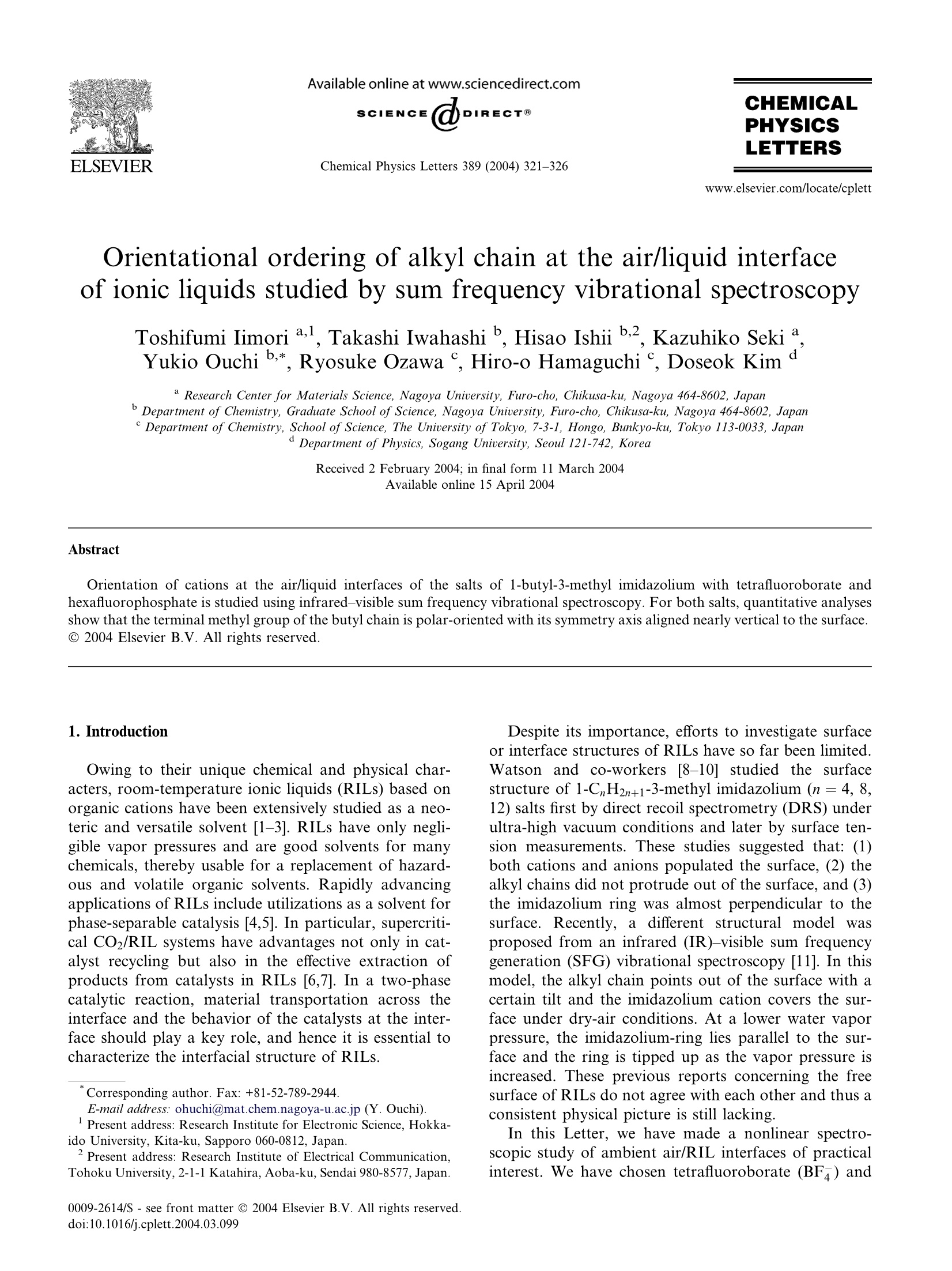
-
2/6
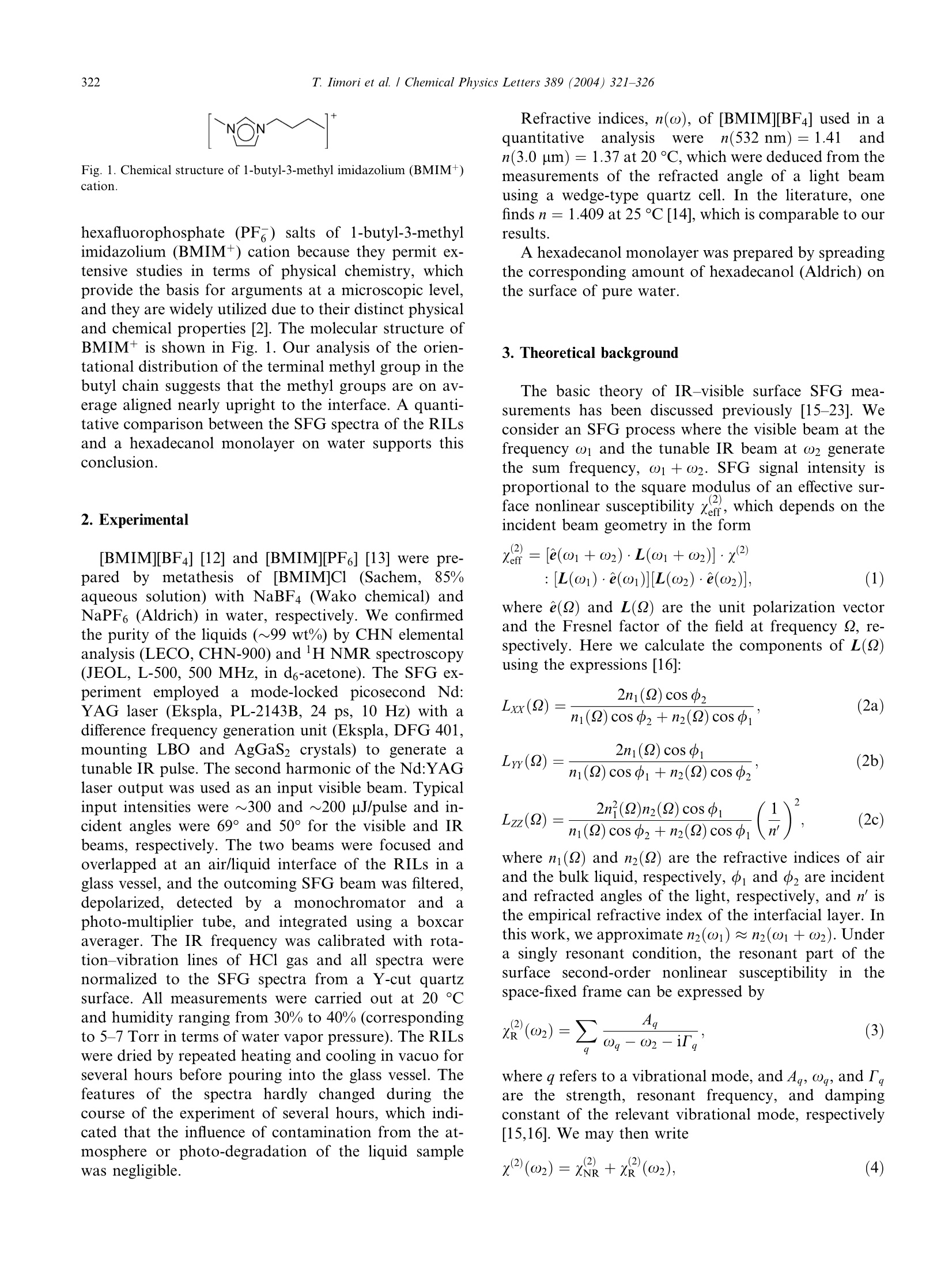
还剩4页未读,是否继续阅读?
继续免费阅读全文产品配置单
北京欧兰科技发展有限公司为您提供《离子液体气/液界面,烷基链中取向度的振动和频光谱(SFG)研究,振动和频光谱(SFG)研究,和频光谱(SFG)研究检测方案(其它光谱仪)》,该方案主要用于其他中取向度的振动和频光谱(SFG)研究,振动和频光谱(SFG)研究,和频光谱(SFG)研究检测,参考标准《暂无》,《离子液体气/液界面,烷基链中取向度的振动和频光谱(SFG)研究,振动和频光谱(SFG)研究,和频光谱(SFG)研究检测方案(其它光谱仪)》用到的仪器有Ekspla SFG 表面和频光谱分析系统、PG411/511 系列接近变换极限线宽的皮秒光学参量发生器(OPG)、Ekspla CARS 相干反斯托克斯拉曼显微光谱仪。
我要纠错
推荐专场
其它光谱仪
更多相关方案
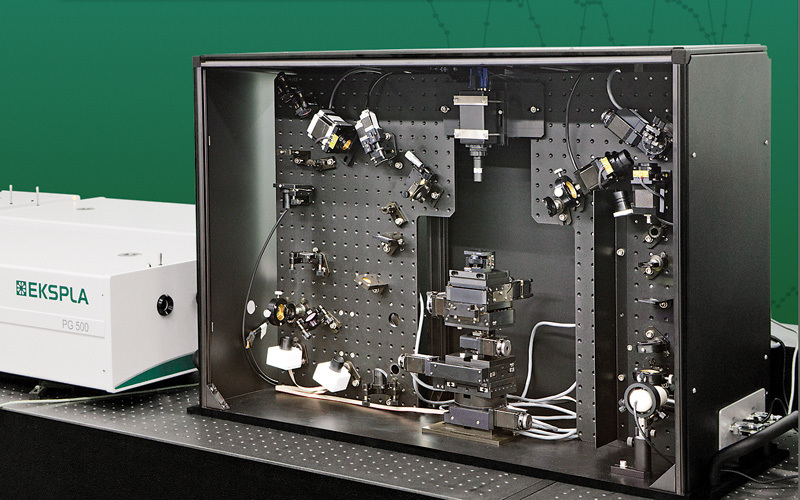

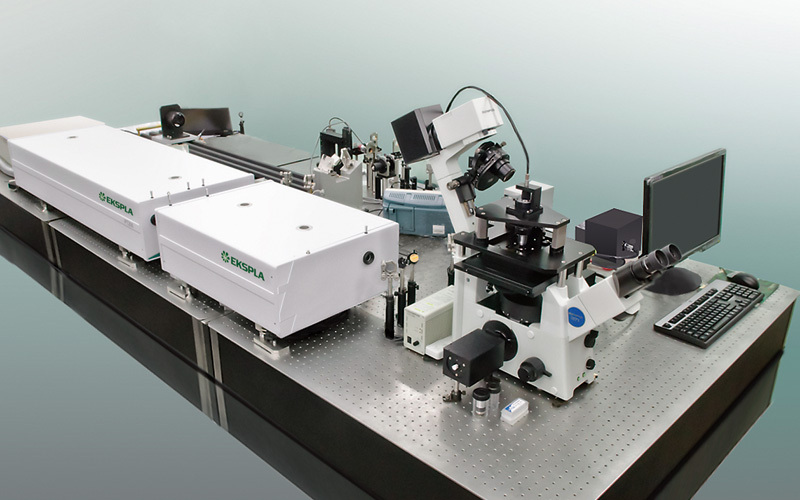
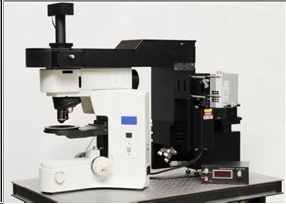
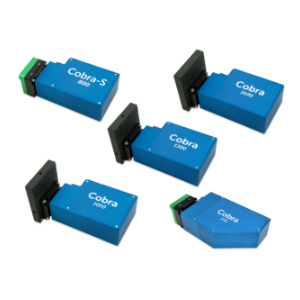
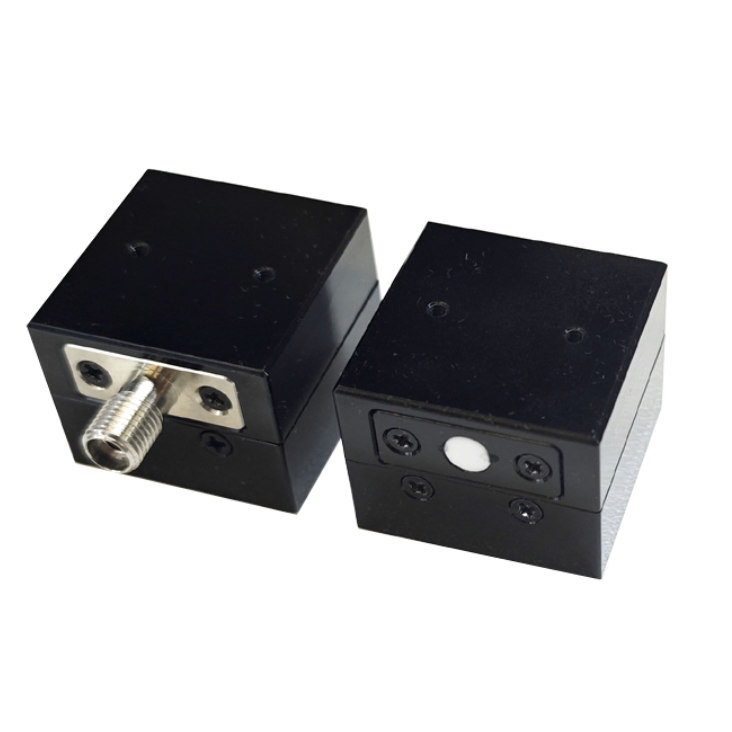



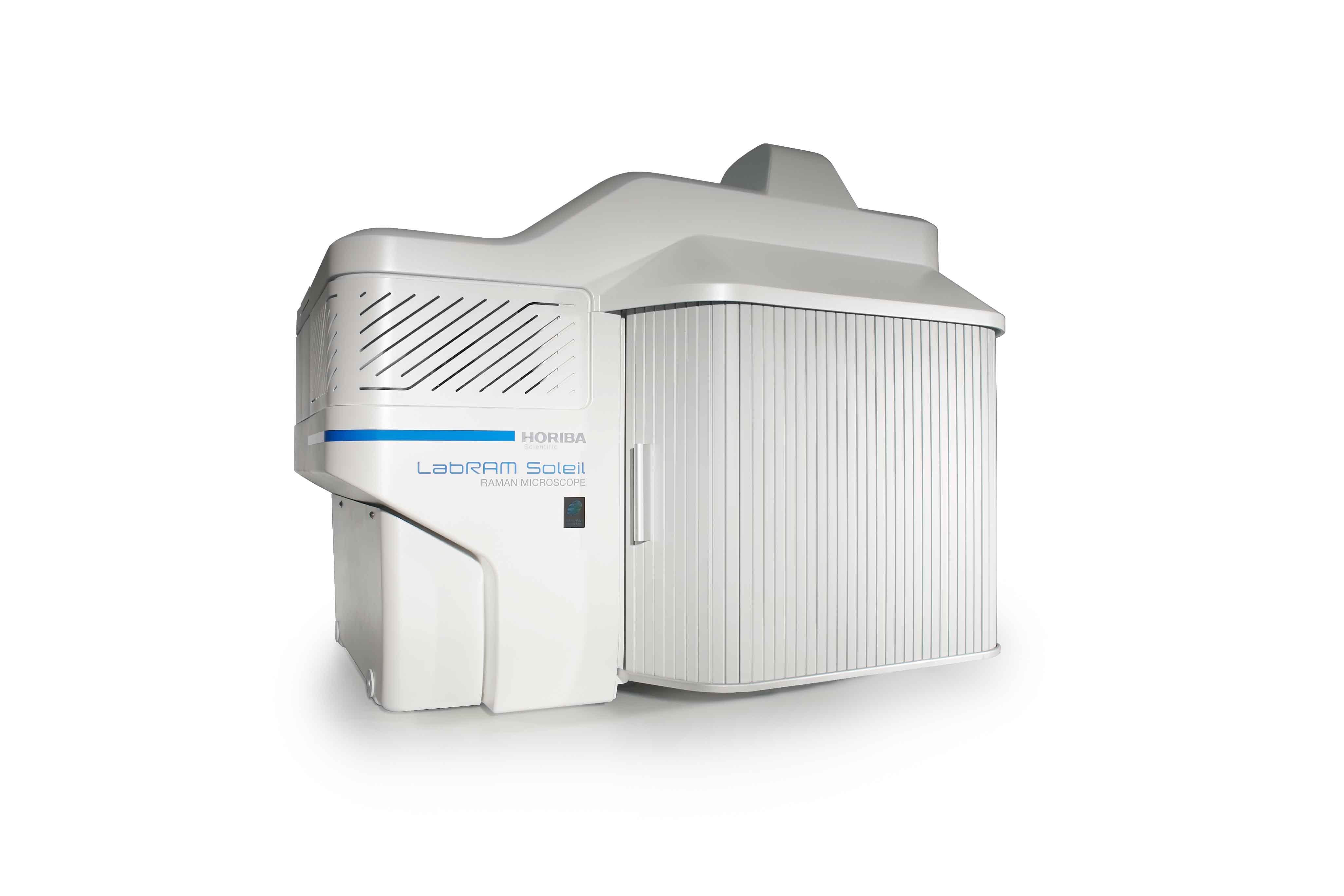

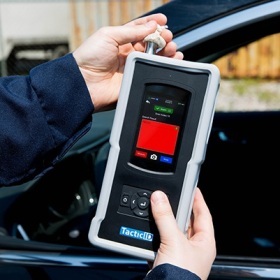
 咨询
咨询